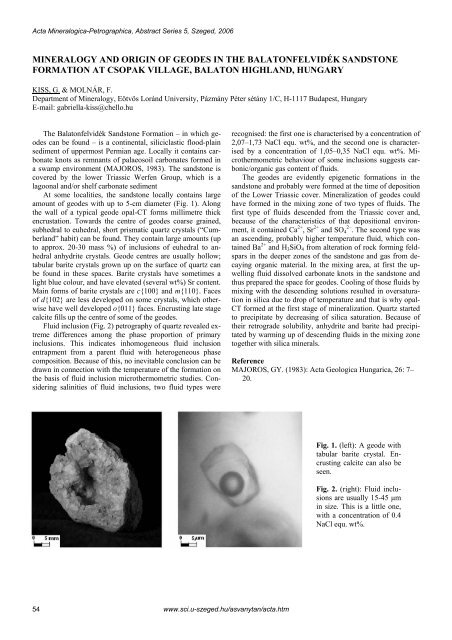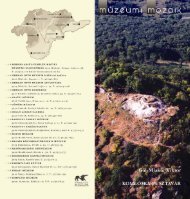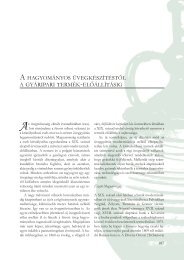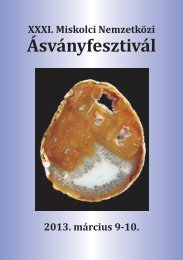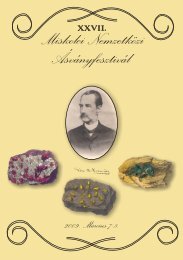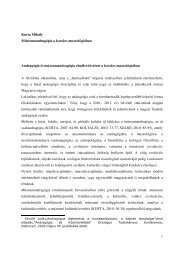Acta Mineralogica-Petrographica, Abstract Series 5, Szeged, 2006<strong>M<strong>IN</strong>ERAL</strong>OGY AND ORIG<strong>IN</strong> OF GEODES <strong>IN</strong> <strong>THE</strong> BALATONFELVIDÉK SANDSTONEFORMATION AT CSOPAK VILLAGE, BALATON HIGHLAND, HUNGARYKISS, G. & MOLNÁR, F.Department of Mineralogy, Eötvös Loránd University, Pázmány Péter sétány 1/C, H-1117 Budapest, HungaryE-mail: gabriella-kiss@chello.huThe Balatonfelvidék Sandstone Formation – in which geodescan be found – is a continental, siliciclastic flood-plainsediment of uppermost Permian age. Locally it contains carbonateknots as remnants of palaeosoil carbonates formed ina swamp environment (MAJOROS, 1983). The sandstone iscovered by the lower Triassic Werfen Group, which is alagoonal and/or shelf carbonate sedimentAt some localities, the sandstone locally contains largeamount of geodes with up to 5-cm diameter (Fig. 1). Alongthe wall of a typical geode opal-CT forms millimetre thickencrustation. Towards the centre of geodes coarse grained,subhedral to euhedral, short prismatic quartz crystals (“Cumberland”habit) can be found. They contain large amounts (upto approx. 20-30 mass %) of inclusions of euhedral to anhedralanhydrite crystals. Geode centres are usually hollow;tabular barite crystals grown up on the surface of quartz canbe found in these spaces. Barite crystals have sometimes alight blue colour, and have elevated (several wt%) Sr content.Main forms of barite crystals are c{100} and m{110}. Facesof d{102} are less developed on some crystals, which otherwisehave well developed o{011} faces. Encrusting late stagecalcite fills up the centre of some of the geodes.Fluid inclusion (Fig. 2) petrography of quartz revealed extremedifferences among the phase proportion of primaryinclusions. This indicates inhomogeneous fluid inclusionentrapment from a parent fluid with heterogeneous phasecomposition. Because of this, no inevitable conclusion can bedrawn in connection with the temperature of the formation onthe basis of fluid inclusion microthermometric studies. Consideringsalinities of fluid inclusions, two fluid types wererecognised: the first one is characterised by a concentration of2,07–1,73 NaCl equ. wt%, and the second one is characterisedby a concentration of 1,05–0,35 NaCl equ. wt%. Microthermometricbehaviour of some inclusions suggests carbonic/organicgas content of fluids.The geodes are evidently epigenetic formations in thesandstone and probably were formed at the time of depositionof the Lower Triassic cover. Mineralization of geodes couldhave formed in the mixing zone of two types of fluids. Thefirst type of fluids descended from the Triassic cover and,because of the characteristics of that depositional environment,it contained Ca 2+ , Sr 2+ and SO 4 2– . The second type wasan ascending, probably higher temperature fluid, which containedBa 2+ and H 3 SiO 4 from alteration of rock forming feldsparsin the deeper zones of the sandstone and gas from decayingorganic material. In the mixing area, at first the upwellingfluid dissolved carbonate knots in the sandstone andthus prepared the space for geodes. Cooling of those fluids bymixing with the descending solutions resulted in oversaturationin silica due to drop of temperature and that is why opal-CT formed at the first stage of mineralization. Quartz startedto precipitate by decreasing of silica saturation. Because oftheir retrograde solubility, anhydrite and barite had precipitatedby warming up of descending fluids in the mixing zonetogether with silica minerals.ReferenceMAJOROS, GY. (1983): Acta Geologica Hungarica, 26: 7–20.Fig. 1. (left): A geode withtabular barite crystal. Encrustingcalcite can also beseen.Fig. 2. (right): Fluid inclusionsare usually 15-45 µmin size. This is a little one,with a concentration of 0.4NaCl equ. wt%.54www.sci.u-szeged.hu/asvanytan/acta.htm
Acta Mineralogica-Petrographica, Abstract Series 5, Szeged, 2006<strong>THE</strong> TECTONIC SETT<strong>IN</strong>G OF <strong>THE</strong> PLUTONIC SEQUENCE <strong>IN</strong> SOU<strong>THE</strong>RN ALBANIANOPHIOLITESKOLLER, F. 1 , HOECK, V. 2 , MEISEL, T. 3 , IONESCU, C. 4 & ONUZI, K. 51 Department of Geological Sciences, University of Vienna, Geozentrum, Althanstr. 14, A-1090 Vienna, AustriaE-mail: friedrich.koller@univie.ac.at2 Department of Geography, Geology and Mineralogy, University of Salzburg, Hellbrunnerstr. 34, A-5020 Salzburg, Austria3 Institute of General and Analytical Chemistry, University of Leoben, A- 8700 Leoben, Austria4 Department of Geology, Babeş-Bolyai University, 1 Kogălniceanu Str., RO-400084 Cluj-Napoca, Romania5 Institute of Geological Research, Blloku Vasil Shanto, Tirana, AlbaniaThe Albanian (Mirdita) Ophiolites are part of a largeNNW–SSE striking ophiolite zone, which comprises theDinaric Ophiolites as well as some Greek ophiolites such asPindos, Vourinos or Othris. Their Jurassic age is constrainedby palaeontological evidence of the sediments on top of theophiolites, by the age of the metamorphic soles and by theage determinations of the intrusive plagiogranite(BORTOLOTTI et al., 2004; DILEK et al., 2005 and referencesherein). The origin of the Albanian ophiolites is essentialto restore the continent/ocean distribution in the Jurassicin the Eastern Mediterranean realm and the possible sites ofthe subduction zones and related thrusts. The environment offormation of these ophiolites and the mode of their emplacementis still controversial.The Mirdita zone is commonly divided into two ophiolitebelts, an eastern one and a western one (e.g. SHALLO et al.,1990). The western belt of the Southern Albanian ophiolitesconsists of six major (Voskopoja, Rehove, Morava, Devolli,Vallamara, Shpati) and two smaller (Luniku and Stravaj)ophiolite massifs. Each massif has a distinct sequence ofmantle tectonites, ultramafic cumulates, cumulate gabbros,troctolites and isotropic gabbros. The western belt was supposedto consist of predominantly MOR-type ophiolites withlherzolites, troctolites, gabbros and MOR-type basalts(HOECK et al., 2002). A volcanic section together with volcanogenicsediments is restricted to the massifs of Voskopojaand Rehove as well as to the small massifs of Luniku andStravaj.The eastern belt is characterized by harzburgites,wehrlites, gabbronorites, clinopyroxene gabbros, plagiogranitesand volcanics. The latter show a wide range ofSSZ compositions from basalts to andesites, dacites andrhyolites (SHALLO, 1994; BORTOLOTTI et al., 1996;ROBERTSON & SHALLO, 2000; BORTOLOTTI et al.,2004).Here we present evidence that at least in southern Albaniathe SSZ influence in the western belt is not restricted to thevolcanic suite but is as well recorded in the ultramafic tectonites,ultramafic and mafic cumulates as in gabbros. Based onthe close spatial and temporal relationship of MOR and SSZmagmas and cumulates, a backarc origin for the Albanianophiolites is discussed.The whole-rock geochemistry and mineral chemistry suggesta mid-ocean ridge environment for the origin of cumulatesand gabbros from Voskopoja, Rehove and Morava, withonly a minor SSZ contribution. The Shpati and the smallLuniku massifs show MOR and SSZ signatures in their plutonicsequence. Cumulates and gabbros from Devolli andVallamara formed in a SSZ environment. The predominanceof MOR-generated crustal rocks and the relatively minoroccurrence of SSZ-generated plutonics together with thevolcanogenic sediments in Voskopoja and Rehove indicate abackarc basin origin of the western belt ophiolites and awestward-dipping subduction zone.ReferencesBORTOLOTTI, V., KODRA, A., MARRONI, M.,MUSTAFA, F., PANDOLFI, L., PR<strong>IN</strong>CIPI, G. &SACCANI, E. (1996): Ofioliti, 21(1): 3–20.BORTOLOTTI, V., CHIARI, M., MARCUCCI, M.,MARRONI, M., PANDOLFI, L. & PR<strong>IN</strong>CIPI, G. (2004):Ofioliti, 29(1): 19–35.DILEK, Y., SHALLO, M. & FURNES, H. (2005): InternationalGeology Review, 47: 147–176.HOECK, V., KOLLER, F., MEISEL, T., ONUZI, K. &KNER<strong>IN</strong>GER, E. (2002): Lithos, 65: 143–164.ROBERTSON, A. H. F. & SHALLO, M. (2000): Tectonophysics,316: 197–254.SHALLO, M. (1994): Ofioliti, 19(1): 57–75.SHALLO, M., KODRA, A. & GJATA, K. (1990): InMALPAS, J., MOORES, E., PANAYIOTOU, A. &XENOPHONTOS, C. (eds.): Ophiolites, Oceanic CrustalAnalogues. Proceedings of the Symposium “Troodos1987”. Nicosia: Cyprus Geological Survey Dept., 265–269.www.sci.u-szeged.hu/asvanytan/acta.htm 55
- Page 1:
MSCC33 rd MINERAL SCIENCES IN THE C
- Page 5 and 6: Acta Mineralogica-Petrographica, Ab
- Page 7 and 8: Acta Mineralogica-Petrographica, Ab
- Page 9 and 10: Acta Mineralogica-Petrographica, Ab
- Page 11 and 12: Acta Mineralogica-Petrographica, Ab
- Page 13 and 14: Acta Mineralogica-Petrographica, Ab
- Page 15 and 16: Acta Mineralogica-Petrographica, Ab
- Page 17 and 18: Acta Mineralogica-Petrographica, Ab
- Page 19 and 20: Acta Mineralogica-Petrographica, Ab
- Page 21 and 22: Acta Mineralogica-Petrographica, Ab
- Page 23 and 24: Acta Mineralogica-Petrographica, Ab
- Page 25 and 26: Acta Mineralogica-Petrographica, Ab
- Page 27 and 28: Acta Mineralogica-Petrographica, Ab
- Page 29 and 30: Acta Mineralogica-Petrographica, Ab
- Page 31 and 32: Acta Mineralogica-Petrographica, Ab
- Page 33 and 34: Acta Mineralogica-Petrographica, Ab
- Page 35 and 36: Acta Mineralogica-Petrographica, Ab
- Page 37 and 38: Acta Mineralogica-Petrographica, Ab
- Page 39 and 40: Acta Mineralogica-Petrographica, Ab
- Page 41 and 42: Acta Mineralogica-Petrographica, Ab
- Page 43 and 44: Acta Mineralogica-Petrographica, Ab
- Page 45 and 46: Acta Mineralogica-Petrographica, Ab
- Page 47 and 48: Acta Mineralogica-Petrographica, Ab
- Page 49 and 50: Acta Mineralogica-Petrographica, Ab
- Page 51 and 52: Acta Mineralogica-Petrographica, Ab
- Page 53: Acta Mineralogica-Petrographica, Ab
- Page 57 and 58: Acta Mineralogica-Petrographica, Ab
- Page 59 and 60: Acta Mineralogica-Petrographica, Ab
- Page 61 and 62: Acta Mineralogica-Petrographica, Ab
- Page 63 and 64: Acta Mineralogica-Petrographica, Ab
- Page 65 and 66: Acta Mineralogica-Petrographica, Ab
- Page 67 and 68: Acta Mineralogica-Petrographica, Ab
- Page 69 and 70: Acta Mineralogica-Petrographica, Ab
- Page 71 and 72: Acta Mineralogica-Petrographica, Ab
- Page 73 and 74: Acta Mineralogica-Petrographica, Ab
- Page 75 and 76: Acta Mineralogica-Petrographica, Ab
- Page 77 and 78: Acta Mineralogica-Petrographica, Ab
- Page 79 and 80: Acta Mineralogica-Petrographica, Ab
- Page 81 and 82: Acta Mineralogica-Petrographica, Ab
- Page 83 and 84: Acta Mineralogica-Petrographica, Ab
- Page 85 and 86: Acta Mineralogica-Petrographica, Ab
- Page 87 and 88: Acta Mineralogica-Petrographica, Ab
- Page 89 and 90: Acta Mineralogica-Petrographica, Ab
- Page 91 and 92: Acta Mineralogica-Petrographica, Ab
- Page 93 and 94: Acta Mineralogica-Petrographica, Ab
- Page 95 and 96: Acta Mineralogica-Petrographica, Ab
- Page 97 and 98: Acta Mineralogica-Petrographica, Ab
- Page 99 and 100: Acta Mineralogica-Petrographica, Ab
- Page 101 and 102: Acta Mineralogica-Petrographica, Ab
- Page 103 and 104: Acta Mineralogica-Petrographica, Ab
- Page 105 and 106:
Acta Mineralogica-Petrographica, Ab
- Page 107 and 108:
Acta Mineralogica-Petrographica, Ab
- Page 109 and 110:
Acta Mineralogica-Petrographica, Ab
- Page 111 and 112:
Acta Mineralogica-Petrographica, Ab
- Page 113 and 114:
Acta Mineralogica-Petrographica, Ab
- Page 115 and 116:
Acta Mineralogica-Petrographica, Ab
- Page 117 and 118:
Acta Mineralogica-Petrographica, Ab
- Page 119 and 120:
Acta Mineralogica-Petrographica, Ab
- Page 121 and 122:
Acta Mineralogica-Petrographica, Ab
- Page 123 and 124:
Acta Mineralogica-Petrographica, Ab
- Page 125 and 126:
Acta Mineralogica-Petrographica, Ab
- Page 127 and 128:
Acta Mineralogica-Petrographica, Ab
- Page 129 and 130:
Acta Mineralogica-Petrographica, Ab
- Page 131 and 132:
Acta Mineralogica-Petrographica, Ab
- Page 133 and 134:
Acta Mineralogica-Petrographica, Ab


